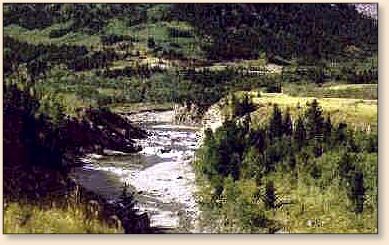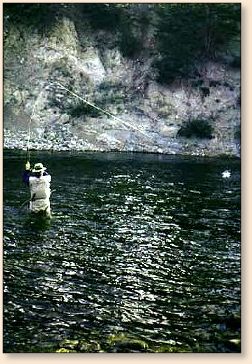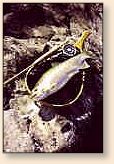The Oldman River System
The Southwestern corner of Alberta seems like a
small earthly sample of heaven to many of us
fly-fishers today, but we are hardly the first
to feel that way. For the last century ranching
families have given thanks for the bounty provided
by endless grasslands waving under warm Chinook
winds. And for centuries before that the Blackfoot
and Peigan Indians knew the headwaters of the Oldman
River to be the home of Na'pi, the Great Spirit
and provider.

The trout waters in the Oldman River drainage are among
Alberta's best. Virtually all flowing waters in the
foothill portion of the drainage carry trout and
whitefish and provide good to superb fishing.
The Big Picture
The streams in the Oldman system are generally small - to
medium- sized with the exception of the lower Oldman
itself, which is a good-sized river. Most are very
clear with boulder and gravel stream beds, deep pools
and fast pocket water. The gradients are often fairly
steep, particularly in the upper reaches.
The upper Oldman and its major norther tributary, the
Livingstone River, begin near the Continental Divide
southwest of Calgary. Both are very good cutthroat
nd bull trout steams, and the Livingstone should get
even better with the recent introduction of no-kill
regulations. The two rivers flow south before joining
and flowing eastward through a narrow slot in the Rockies
aptly called the Gap. Downstream of the Gap rainbow
trout begin to appear as the river winds eastward
through a beautiful piece of ranch country called
the Whaleback. The river bends south again, and
by the time it approaches and enters the Oldman
Reservoir, rainbows have become the dominant fish.
The Crowsnest River enters the same reservoir from
the south, as does the Castle River a little farther
to the east.
 The Castle is a fine stream for cutthroats and rainbows,
and is made up of a number of equally appealing tributaries,
including Lynx Creek and the Carbondale River, both of
which are good cutthroat and bull trout streams. The
West Castle is noted for its willing cutthroats and the
fact that it stays clear when most other streams in the
area are muddy from heavy rain. Stretches of the West
and South Castle were formerly accessible from rough
logging rods, but the spring floods of 1995 took
portions of these roads out, and it is unlikely they
will be rebuilt, at least not in the near future.
This will probably make the fishing even better for
those who don't mind hiking in.
The Castle is a fine stream for cutthroats and rainbows,
and is made up of a number of equally appealing tributaries,
including Lynx Creek and the Carbondale River, both of
which are good cutthroat and bull trout streams. The
West Castle is noted for its willing cutthroats and the
fact that it stays clear when most other streams in the
area are muddy from heavy rain. Stretches of the West
and South Castle were formerly accessible from rough
logging rods, but the spring floods of 1995 took
portions of these roads out, and it is unlikely they
will be rebuilt, at least not in the near future.
This will probably make the fishing even better for
those who don't mind hiking in.
Downstream of the reservoir the Oldman River dodges
to avoid the south end of the Porcupine Hills and moves
out across flatter ground through the Peigan Indian
Reserve, past Head-Smashed-In Buffalo Jump and through
the town of Fort Macleod.
The Oldman reservoir was created in the early 1990s
with the construction of an irrigation storage dam
on the mainstream of the Oldman River a short distance
below the confluence of the Oldman, Castle and Crowsnest
rivers. The dam turned twenty-eight miles of the rivers
into a giant, three-toed reservoir.
With the completion of this dam many trout fishers,
including this one, were angered at the loss of huge
portions of Alberta's best trout streams. Some
consolation was the hope that a good tailwater
fishery might develop in the Oldman below the dam.
A tailwater fishery is one that develops downstream
of a bottom-draw dam. Because the water comes from
the bottom of the reservoir, it is consistently cool,
and cold-water trout habitat sometimes extends
downstream farther than normal. It is too early
to be sure, but as of this writing [1996] it
appears that this might be happening.

The Oldman is a different river below the dam. The
insect life is dense and more reminiscent of that
in the Crowsnest then the upper Oldman. Hatches
of Pale Morning Duns, Blue-Winged Olives, midges
and caddis are heavy and there are plenty of
fourteen- to sixteen-inch rainbows and good-sized
whitefish there to eat them.
But this is still a good news - bad news story.
The good news is that the fishing is improving
below the dam. The bad news is that just six
miles below the dam, the river enters the Peigan
Indian Reserve, where fishing is not permitted.
There are about twenty-five miles of the Oldman
River inaccessible within the the Peigan Reserve,
and below there the river is somewhat of an unknown
quantity. In the early 1990s brown trout were
planted in this part of the river to kick start
this part of the fishery, and these fish are
beginning to turn up in angler's catches. It is
hoped that when this fishery matures it will provide
good angling downstream as far as Lethbridge. ~ Jim McLennan
Credits: Text from Trout Streams of Alberta by Jim McLennan,
published by Johnson Gorman. Photos from www.FlyFishAlberta.com.
Our Man In Canada Archives
|


 The Castle is a fine stream for cutthroats and rainbows,
and is made up of a number of equally appealing tributaries,
including Lynx Creek and the Carbondale River, both of
which are good cutthroat and bull trout streams. The
West Castle is noted for its willing cutthroats and the
fact that it stays clear when most other streams in the
area are muddy from heavy rain. Stretches of the West
and South Castle were formerly accessible from rough
logging rods, but the spring floods of 1995 took
portions of these roads out, and it is unlikely they
will be rebuilt, at least not in the near future.
This will probably make the fishing even better for
those who don't mind hiking in.
The Castle is a fine stream for cutthroats and rainbows,
and is made up of a number of equally appealing tributaries,
including Lynx Creek and the Carbondale River, both of
which are good cutthroat and bull trout streams. The
West Castle is noted for its willing cutthroats and the
fact that it stays clear when most other streams in the
area are muddy from heavy rain. Stretches of the West
and South Castle were formerly accessible from rough
logging rods, but the spring floods of 1995 took
portions of these roads out, and it is unlikely they
will be rebuilt, at least not in the near future.
This will probably make the fishing even better for
those who don't mind hiking in.